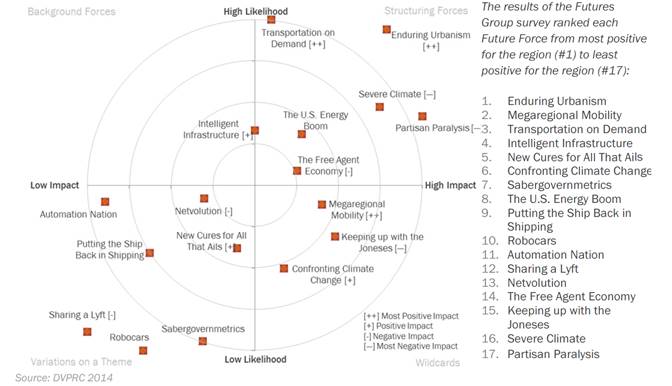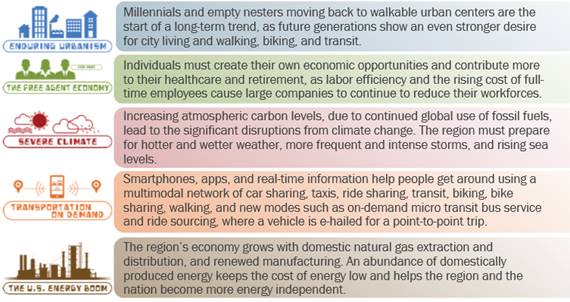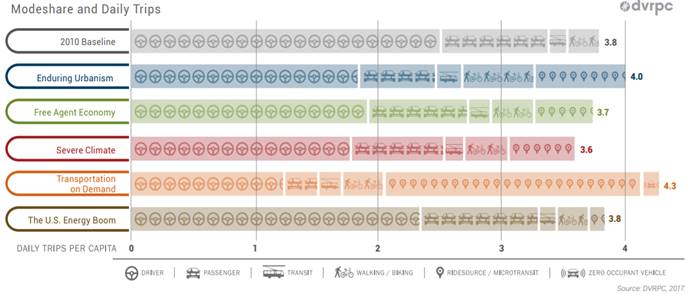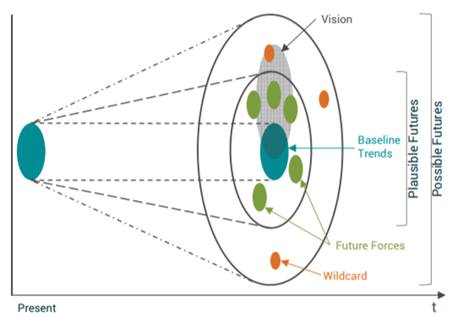US Department of Transportation
FHWA PlanWorks: Better Planning, Better Projects
Scenarios for Technological Change and Uncertainty
Delaware Valley Regional Planning Commission
DVRPC engaged in an exploratory scenario planning process to test transportation investments against a range of potential future scenarios.
- The MPO first established a Futures Group made up of a diverse set of experts and stakeholders from traditional and non–traditional fields to identify potential "forces" impacting transportation in the region.
- These forces then informed "what–if" scenarios which DVRPC used to model socio–economic and transportation impacts.
- DVRPC held a larger public outreach campaign to develop a vision for the long–range transportation plan (LRTP), considering the impacts of the "what–if" scenarios.
Executive Summary
The Delaware Valley Regional Planning Commission (DVRPC) is the MPO for the Greater Philadelphia region. In 2014, DVRPC convened a group of nearly 70 regional stakeholders from academia, the private sector, nonprofit organizations, and government to explore broader social, technical, economic, environmental, and political (STEEP) trends and develop scenarios of regional change. They did this during the scoping stage ofConnections 2045, the region's long–range transportation plan (LRTP). DVRPC analyzed and modeled these future forces scenarios as five what–if outcomes, highlighting potential shifts in transportation demand and identifying specific opportunities and challenges for the region over the plan's 30–year horizon. They also considered interactions between the different future forces and their potential impacts and outcomes.
In response to the five scenarios, DVRPC developed a set of universal actions that would benefit the region regardless of future developments, and a set of contingent actions that were specific to each scenario. These actions were not limited to DVRPC's transportation/land use planning areas but rather were actions to be implemented by implementers and decision makers throughout the region. Using the five scenarios along with regional trends and forecasts, DVRPC convened a series of public workshops and conducted online surveys to understand residents' values and investment priorities in this climate of technological change and uncertainty. From these workshops, DVRPC identified five core principles to drive regional policy and transportation investment priorities.
Agency's Challenge
DVRPC, the federally–designated Metropolitan Planning Organization (MPO) for the nine–county Greater Philadelphia region, serves Bucks, Chester, Delaware, Montgomery, and Philadelphia counties in Pennsylvania; and Burlington, Camden, Gloucester, and Mercer counties in New Jersey. DVRPC has performed scenario planning as part of their long–range planning process for over 10 years. The agency undertakes a scenario planning exercise in support of long range transportation plan updates every four years.
While DVRPC's past LRTP updates focused on land use, transportation funding, and resident preferences, the agency's most recent focus addressed future technologies.
The agency typically developed scenarios in–house and presented their findings to the public for comment, primarily through workshops and online surveys. In 2014, DVRPC developed a white paper reflecting on their work in scenario planning and establishing recommendations for future processes. The white paper concluded that working with outside partners and considering a diverse group of viewpoints early in developing the scenarios would be an important next step for DVRPC. Additionally, by involving external stakeholders, experts, and decision makers, DVRPC hoped to generate more attention and support for the plan.
Exploratory Scenario Planning
Types of Scenario Planning
- Predictive: Scenarios built according to probable or likely trends.
- Normative:Scenarios built according to desirable future conditions.
- Exploratory:Scenarios built according to selected future conditions, which may be unknown or uncontrollable.[1]
Although there are multiple types of scenario planning, FHWA generally categorizes scenario planning into predictive, normative, and exploratory models. ForConnections 2045, DVRPC transitioned from a normative model to one that is exploratory for use in the LRTP to help understand diverse and unpredictable future scenarios. Exploratory scenario planning can be described as first identifying driving forces, typically falling in the categories of social, technical, economic, environmental, and political (STEEP) changes. The method is often used to consider emerging trends and technologies, including autonomous vehicles or other potential large–scale changes which cannot be predicted looking at current trends. In 2017, DVRPC participated in a FHWA–sponsored peer exchange with representatives from other MPOs to discuss how agencies were using innovative scenario planning analyses (Figure 1).[2]DVRPC determined that exploratory type of scenario planning would be a good way to consider a range of futures amid several unpredictable factors. DVRPC's Manager of Long–Range Planning noted in the peer exchange that DVRPC's scenarios need to be updated over time as new information and perspectives become available. They noted that the scenarios may not have adequately captured the impacts of the "digital revolution", low–cost energy scenarios, and infrastructure maintenance needs.
Futures Group
In 2014, DVRPC convened the Greater Philadelphia Futures Group, which included experts in a variety of disciplines (economic, planning, education, health, environment, technology, environmental justice, aging, and engineering) to inform scenario planning for the LRTP. DVRPC had engaged external stakeholders for previous LRTPs, however, the Futures Group was much more diverse in its membership. The Futures Group was tasked with identifying "driving forces of change" in the Greater Philadelphia region through a brainstorming exercise of experts to assess potential/likely changes that will occur in the future and impact the region.[4]"Driving forces" are not goals or aspirational conditions, rather, they are imagined trends or changes that will impact the transportation system and related industries. The selected scenarios from this activity effectively form the scope of the LRTP. Futures Group members included stakeholders from:
- State Departments of Transportation and Environmental Protection
- Universities
- New Jersey Department of Environmental Protection
- Technology experts
- Planning consultants
- Engineering consultants
- Economic research consultants
- Philadelphia Regional Port Authority
- Transportation Management Associations
- DVRPC–member counties and cities, Smart Growth, Education, and Environmental Advocacy Groups, Transit agencies[5]
Future Forces and What–if Scenarios
The Futures Group initially identified 31 forces of change, or future forces, which were exploratory rather than normative. Following initial brainstorming sessions, the Futures Group revised and reduced the future forces to 17, which were then evaluated for impact and likelihood based on online voting from Futures Group members and DVRPC's Regional Technical Committee (RTC). It was ultimately decided to focus on the Structural Forces (High Impact and High Likelihood) and the five key forces were selected from that quadrant (Figure 2). These were intended to help decision makers understand how change is likely to occur and use that to guide regional decision making.

Figure 2: Likelihood and Impacts of Identified Forces on Region Based on Ranking by Futures Group.
In addition to five key future forces, the Futures Group also identified key background forces (e.g., partisan paralysis, intelligent infrastructure, connected vehicles, and healthcare technologies) that are likely to impact the future, but to a lesser extent than the Future Forces. These are incorporated into all the future scenarios.

Figure 3: Five key future forces.
It is important to note that while the Futures Group members voted on the level of impact and likelihood of the future forces, DVRPC used its knowledge and expertise in the transportation industry to craft details of the what–if scenarios (Figure 3). For example, a majority of the Futures Group members indicated that there was a low likelihood of autonomous vehicles having a high impact on the transportation industry within the next 25 to 30 years. However, DVRPC conducted an additional study on networking transportation, including looking at the impacts of the digital revolution, shared transportation, and autonomous vehicles which was used in the development of strategies in the long–range transportation plan. DVRPC has continued to convene a Futures Group for future long–range planning processes, as emerging trends may change rapidly, and diverse set of experts will help identify the next upcoming potential issues.
"What–if" scenarios were developed for the future forces based on dialogue with the Futures Group and research conducted by DVRPC. These scenarios were developed to highlight any changes within the region over the next couple of decades, to address likely shifts in travel demand, and to identify region–specific potential opportunities and challenges. For the various "what–if" scenarios, the Futures Group considered likely potential outcomes of each force within the region, along with key assumptions related to population, employment, income levels, vehicular fuel efficiency, and the cost of a gallon of gasoline (or equivalent energy source) in 2045.
DVRPC tested the scenarios using travel demand and socio–economic impacts modeling tools to identify transportation and social impacts of each (Figure 4). DVRPC utilized strategic models and scenario planning tools such as Impacts 2050[6], a socio–demographic systems dynamic model, and Rapid Policy Assessment Tool (RPAT), a sketch level travel demand model, for this scenario planning exercise. However, because of limitations of these tools to predict major changes at a regional level, DVRPC is exploring other analytical alternatives such as newer land use models and Regional Strategic Planning Model (RSPM), to develop future scenario exercises. Currently DVRPC is working on updating the Impacts 2050 model to include region–specific scenario planning capability.

Figure4: Modeshare and Daily Trips for each "What–if" Scenario.
- LRP–1: Approve Scope of LRTP Process. Partners and key stakeholders helped DVRPC construct future scenarios by providing data and insights into trends and future issues. The scenarios were used in the LRTP to guide decisions in anticipation of possible future conditions.
- LRP–2. Approve Vision and Goals. DVRPC developed a vision and core principles for the plan using input from the Futures Group and a public outreach campaign.
Establishing these "what–if" scenarios helped define the scope of the long–range transportation planning process. DVRPC included key stakeholders and experts who provided important data and concepts about regional conditions which should be considered in the planning process. The brainstorming format and idea–gathering process empowered the stakeholders and partners to play an active role in establishing the scope of the planning process.
In addition to developing and analyzing the "what–if" scenarios independent from each other, the Futures Group and DVRPC also considered the interactions between the different Future Forces and potential impacts and outcomes, if the forces were to occur simultaneously.
Universal and Contingent–Regional Actions
Once the team identified significant future forces, DVRPC task forces and the Futures Group prepared a list of short– and medium–term actions, which included policy directives and workforce skills necessary to effectively mitigate potential challenges posed by the identified future forces. These actions were broadly categorized as:
Universal Actions,which were deemed beneficial to the region regardless of which forces come into play in the future. These actions were geared towards DVRPC's broad vision of improving quality of life and enhancing regional amenities within the region. Among the examples of identified universal regional actions included creating lifelong communities to age in place, regional/local big data teams, freight enhancement plans, and infrastructure resiliency plans.
Contingent Actions,are specific to each Future Force. To help determine if a Force was happening, the group identified two or three leading indicators for each of the five forces (Table 1).
Future Force | Leading Indicators |
Enduring Urbanism |
|
Free Agent Economy |
|
Severe Climate | Global atmospheric CO2parts per million. Average regional temperature and precipitation. Delaware River sea level rise. |
Transportation On Demand |
|
U.S. Energy Boom |
|
Table 1. Regional leading Indicators for future forces.
Stakeholder Collaboration
In 2016, DVRPC held public workshops where they presented the five future scenarios and current trends. The public discussed conditions and scenarios and drafted a vision for the region in 2045. This was based on what they would like to see in the region, in part in response to the five possible scenarios. The vision includes five core principles (Sustain the Environment, Develop Livable Communities, Expand the Economy, Advance Equity and Foster Diversity and Create an Integrated, Multimodal Transportation Network). On–line surveys captured additional input from those who could not attend in–person workshop. With the "what–if" scenarios in mind, DVRPC developed goals and strategies based on the universal actions and contingent actions that would be instrumental in realizing the vision and principles determined by the public.
Key Outcomes
The following are key outcomes of DVRPC'sConnections 2045planning process:
- DVRPC developed a robust working group, comprised of traditional and non–traditional stakeholders, which helped expand DVRPC's understanding of forces impacting the region's future. The group helped identify trends outside of the traditional transportation planning topics that may have significant impacts on the transportation system and travel behavior.
- DVRPC solicited public input for the plan's vision and leading principles based on public preferences and understanding of potential future forces.
- DVRPC and the Futures Group identified five key future forces of change anticipated to cause the greatest impact on the transportation system and related industries within the Greater Philadelphia region.
- DVRPC and the Futures Group identified universal actions, contingent–regional actions, and leading indicators to mitigate potential impact of key future forces in the Greater Philadelphia region. They used these actions to develop strategies to realize the plan's vision.
- The quality of scenario planning and models are reliant on the quality of data and parameters used in the models. DVRPC noted that the scenarios will constantly need to be updated and re–imagined with input from internal and external partners.
For More Information
Contacts
Brett FuscoManager
Long–Range Planning
DVRPC
bfusco@dvrpc.orgMichael Boyer
Associate Director
Comprehensive Planning
DVRPC
mboyer@dvrpc.org
[1]FH WA. Advancing Transportation Systems Management and Operations through Scenario Planning. Modified February 2017.
[2]FHWA. Mid–America Regional Council Scenario Planning Workshop. February 2017
[6]Zmud, J.P., Barabba, V.P., Bradley, M., Kuzmyak, J.R., Zmud, M. and Orrell, Strategic Issues Facing Transportation, Volume 6: The Effects of Socio–Demographics on Future Travel Demand(No. Project 20–83 (6)). Transportation Research Board of the National Academies, Washington DC. 2014.

